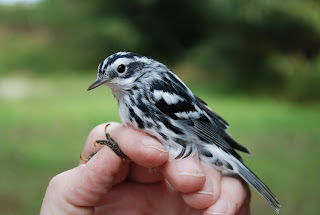Well Sunday morning was a break in the oppressing hot, humid weather we had been experiencing for the past week and Monday looked to be hot again so I had a small window for banding. I sat for 3 hours and caught not a single bird and the landscape was pretty quiet except for high flying Cedar Waxwings and a very vocal Cooper's Hawk down the lane. Then at 10:30 we saw some flitting along the edge of the trail and it was definitely warblers foraging in the brush. A quick check of the nets made the waiting worthwhile.
This bird was a first for me. I had never banded a Black-Throated Green Warbler before and was I excited! Fall warblers can be a challenge but this individual was very cooperative. Pretty stunning in the hand.
Then of course there are the truly difficult fall warblers. This fall plumaged Bay-breasted Warbler can give you fits when compared to a fall plumaged Blackpoll Warbler. Luckily having caught one last fall I knew what to look for and the coloration on the sides of the bird and the color of the feet clinched this one for me. Always kind of exciting when you walk up to the net and go "uh-oh".
If they were all easy it wouldn't be as much fun now would it? We had a total of 13 birds, but as is typical of migrating warblers, they were a mixed flock and we only got one of each species.
Other birds we caught with these warblers included 3 Black-capped Chickadees, 4 Red-eyed Vireos and a Downy Woodpecker.
One of my favorite warblers (if one can have a favorite from this group) is the Black and White Warbler. Not only is their coloration striking, their behavior is so not like other warblers at times.
Finally we have a Magnolia Warbler. Another great catch and looking so different from when we catch them in the spring. The white band across the entire tail is an easy ID mark. It looks like it's having a bit of a "bad hair day" because I had to look at its skull to see if it was a young bird or not.
"Skulling" is another one of those odd skills banders work on in order to get the best data they can from the birds they handle. It sounds worse than it actually is. A young birds skull, like a young human, is not fully formed when it hatches. By wetting the head feathers and looking at the skull through the thin skin on the head you can often see "edges" where the bone is still growing to form a complete skull. Some species might not finish forming their skull until well into the winter.
Things should be picking up for the next few weeks. Once the warblers push through we'll see the sparrows next. If you think fall warblers are tough you ought to see young sparrows in the fall...







2 comments:
Interesting article! I'm wondering if you would consider doing a post on creating and managing your "lanes". I'm new to the world of birding and haven't seen information about lanes before.
Nice photos. Thanks for sharing with those of us who don't manage to get out and see them for ourselves.
Post a Comment